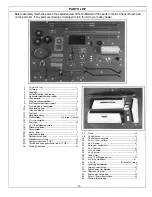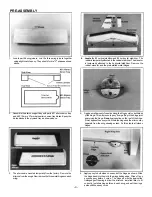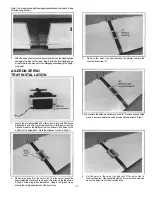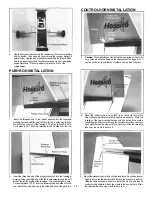
AILERON SERVO INSTALLATION
1. Route the servo wire through the side of the tray as shown. Using
the screws supplied with your radio, mount the servo into the tray.
Install the clevises on the threaded ends of the aileron control rods.
Connect the control rods to the aileron horns. Center the aileron
servo arm and measure the length of rod needed. Use the same
procedure to connect the aileron control rods to the servo arms as
used in control rod adjustment Step 5. Uneven aileron centering will
cause severe turns.
2. Turn both the transmitter and receiver switches on. Center the trim
levers on the transmitter. Rotate the clevises in the proper direction
to center the control surfaces (clockwise - shortens the length). The
rudder should have 1" of throw to each side. The elevator 1/2" up and
1/2" down.
3. If the receiver antenna should get caught, the receiver could possibly
be damaged. By putting a strain relief on the antenna the damage
may be prevented. Cut an arm off of a servo arm as shown above
and thread the receiver antenna through the three holes. Position
this about 6" from the receiver.
4. Drill a 1/16" hole in the side of the fuselage and the upper portion of
the vertical stabilizer. Install the strain relief close to the receiver. Route
the receiver antenna through the holes as shown. This configuration
should allow for the best radio reception. Move the strain relief up to the
hole in the fuselage. Leave some slack in the antenna between the
receiver and the strain relief. Do not cut the antenna. Make another
strain relief to hold the antenna to the tail.
At this time be certain that the aileron servo is connected to the receiver,
otherwise the wing will need to be removed later to connect it. The wing
is mounted to the fuselage by using (8) #64 rubber bands. Wrap the bands
around the wooden dowels as shown above. This design is to allow for
those not-so-penect landings that come with learning how to fly. The
bands are designed to pop off during hard landings and thus help prevent
major damage. Four rubber bands are needed per side.
CENTER OF GRAVITY
The center of gravity is a very important aspect of setting up the airplane
property. It will control a large part of what type of flying characteristics
your plane will have, if it is nose heavy the airplane will try to dive, and the
elevator will be sluggish to respond to your control inputs. If the plane is
tail heavy the airplane will be very sensitive to the elevator and possibly
uncontrollable. The center of gravity should be checked with the fuel tank
empty in the plane to be accurate. The range in which the airplane should
balance is 3 1/2" to 4" back from the leading edge of the wing. With
standard radio equipment, the plane should balance within this range. If
it does not balance within this range, feel free to add weight to the nose
or tail as you need to obtain proper C.G.
RADIO CHECK
Always check the operation of your radio before you fly to see that the
control surfaces move in the proper directions and that they move the
proper amount. If the direction of rotation needs to be reversed to correct
for reversed controls, simply change the side of the servo arm to which the
push rod is attached. To INCREASE the amount of movement that the
surface will have, move the CLEVIS CLOSER to the surface or move the
(SNAP 'R' KEEPER OR E-Z CONNECTOR) away from the center of the
servo arm. To DECREASE the amount of movement, move the CLEVIS
AWAY from the surface or move the (SNAP 'R' KEEPER OR E-Z
CONNECTOR) closer to the center of the servo arm.
- 1 6 -



















